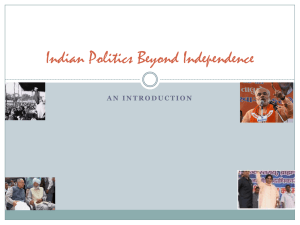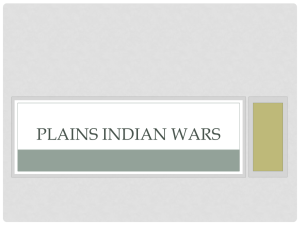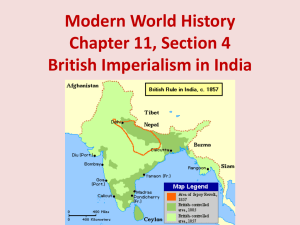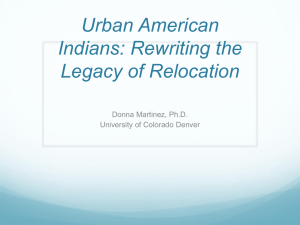“First Nation Healthcare coverage, and who pays for it...”
advertisement
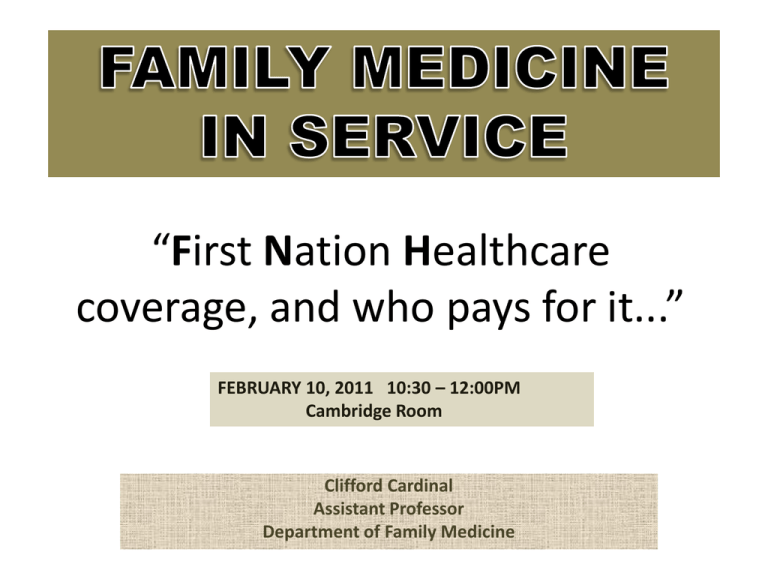
“First Nation Healthcare coverage, and who pays for it...” FEBRUARY 10, 2011 10:30 – 12:00PM Cambridge Room Clifford Cardinal Assistant Professor Department of Family Medicine These may be the ones who may be dealing with this issue at the time health coverage becomes a major issue. 4th year medical students during Community Health 515 Potential reduction in access to appropriate funded and responsive primary health care for the First Nations People in Canada. • Early institutionalized contact policies (pre 1860) recognized First Nations as foreign to the Crown thereby supporting the right to conquer and rule them. • In Post Confederation protective paternalistic policies (1860 – 1920) saw the establishment of the Reserve System and Adoption of the Indian Act 1867. • Policies followed paternalism and saw the growth of Residential Schools (1920 – 1996) which had the First Nations losing language, culture and identity as well as pandemics of the times which saw the loss of many Indians. Hospitals were build. • Parallel health institutions created Federal Gov’t, after this it period was thought that preferential treatment was given to First Nations, and therefore hospitals were closed as were other community health centers (1985 Indian Act) and in the eyes of many Canadians undeserving of such opportunities (Newhouse, 2004). IIm! • Women who married non-Indians lost their treaty rights up until 1985 when Bill C-31 was legislated across Canada. These women and their male children health care was restored. When their Rights were restored, the influx resulted in new Band Members, some as much as 1/3rd was added on to their memberships but with no raise in the Capital Spending for Health Care. Mention difference : Indians; who never lost their Rights. Registered Indians; after 1985 Bill C-31 of Children of women who gained rights. Non-Status; ineligible children. • This dramatic increase in population and entitlement offered in onReserve communities as a result of Bill C-31 was never met with an adjustment in health costs, budgets and services, (Lavoie et al 2005;2007). (Will repeat this as time goes by to emphasize) • Other Benefits and Services such as eye glasses, medication, medical transport, and dental care provided under the Non- Insured Health Benefits (NIHB) and applies uniquely to registered Indians living in on-Reserve communities. . • Complex issue of defining Indian Status; include who is living on reserve and off reserve for funding of their primary health care needs. Non-status implying, an ineligible “Indian for Registration” and may be resultant from; children/offspring on waiting list as applicants still need someone to confirm heritage and blood lineage. Many are denied. Many are still waiting approvals. Many are simply at the mercy of Chiefs and Councils. • Funding for primary health care does not include reserve residents who are not eligible for registration under the Indian Act of 1867. The Policy assumes that those individuals will travel to provincial health care facilities. Therefore the large numbers coming to cities. Although they are Indians in blood, they may be not-registered in any Bands. It is the duty of the Mother to Register their babies after delivery, more than 1/3rd are not registered or waiting to be reg’d. . • Funding arrangements for status First Nations people reveal the following: First Nation and Inuit Health Branch (FNIHB) has primary responsibilities to fund all reserve services. NIHB has extended its responsibilities to off-reserve Status Indians. Indian and Northern Affairs Canada (INAC) provides limited responsibilities in the area of infrastructure and long-term care. Alberta Health and Wellness is responsible for acute care costs and physician services for the entire population through prov. insured health benefits. Public Health also offers services for off-reserve Indians, but is not targeted specifically for First Nations but to vulnerable populations such as Newly Arrived Immigrants'. • Cultural damage as to who is an Indian and who is not an Indian, and ultimately loss of status of so many woman and children who are no longer recognized—and in many cases, no longer identify— as Indians is incalculable. 1. When individuals do find their way to off-reserve healthcare, however, research shows that tacit and overt discriminatory practices and policies continue to marginalize many First nation individuals in the mainstream health care system (Browne, 2005; 2007; Tang and Browne, 2008; Varcoe and Dick, 2008). 2. Negative healthcare experiences stem from encounters with a health care system that tend to reflect dominant discourses about First nations people as relatively irresponsible, dependent, and in some cases undeserving of health care, reflecting persistent stereotypes and misinformed assumptions. 3. Federal Gov’t has so far failed to align funding with population growth. 4. It is unlikely that FNIHB will expand the scope of its coverage's to include those individuals that will be eligible for registration (Bill C-3) for reasons unknown. However, since 1994, FNIHB policy has been to “get out” of business of providing direct health services delivery (Health Canada[MSB], 1995. 5. First Nations who manage their health services have inherited budgets locked at the level of historical expenditures in place when they signed their first agreements, with limited provision for population growth. 6. Onus is placed on First Nations to redress and promote the health of communities, despite the lack of funding available for health promotions. Meaning they are telling First Nation people to get well themselves, don’t get sick, we will however fund pandemics (Public Health Agency of Canada). (et al Pimatisiwin, Journal of Aboriginal and Indigenous Community Health 8(1). 2010. p.91) 1. First Nations who have never lost their Indian status are registered as “Indians” under the Indian Act article 6(1). Those who lost status by marriage or other discriminatory (living off-reserve, gaining meaningful employment, attaining Gr. 12, having money in Bank...) means prior to 1985 are eligible for registration under the Indian Act 6(2). Both 6(1) and 6(2) classifications categories imply full status and benefits. They become “Status Indians”. Indians who have neither parent who was an Indian under the Indian Act are “non-Status Indians or unregistered Indians” who receive no Federal health care benefits. 2. Today if an Indian lives off-Reserve they become ineligible for healthcare benefits and fall under provincial care. 3. For First Nations, the Treaties were understood as an exercise of self – preservation, in light of the American Indian Wars, demise of Bison, and devastating impacts of the epidemics of 1885 – 1927. KEY POINTS • Over 1/3 of current prescription are not funded by past obligations that Federal Government had with First Nations’ People under Treaty. • Attempts to address the inequalities experienced by Firs Nations creates barriers to accessing primary health care on reserve, result in increased secondary and tertiary care and increased financial burden on Provincial health care budgets. • Current policies as designed, promote the disintegration of First Nation communities and will result in increased social inequities and unmet health care needs of Treaty Indians. In Edmonton there are 22,440 of the 689,025 “Indians” in Canada.






